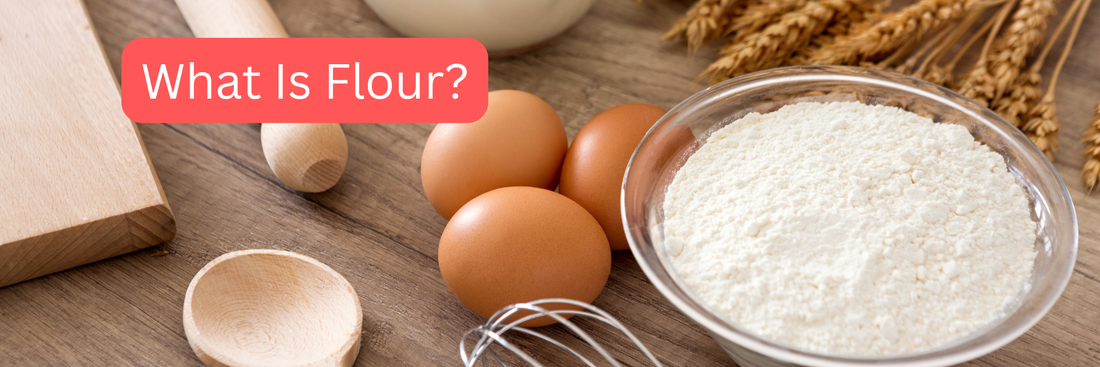Flour is one of the most essential ingredients in cooking and baking. From soft loaves of bread to crispy pastries, flour provides structure, texture, and flavor to countless recipes. But what exactly is flour, how is it made, and what types of flour are best for different uses?
In this article, we’ll explore everything you need to know about flour from its origins and processing methods to its nutritional content and modern alternatives.
-
What is Bread Flour? How Does It Differ From All-purpose Flour?
-
Does Flour Go Bad? How to Tell, How Long It Lasts, and What to Do
-
Best Pastry Flour: Ultimate Guide to Choosing the Perfect Flour for Your Baking
What Is Flour?

Flour is a finely ground powder made by milling grains, seeds, nuts, or roots. The most common type is wheat flour, produced by grinding whole wheat kernels. The main components of flour starch, protein, and fiber give baked goods their structure and texture.
Flour has been used for thousands of years across cultures and cuisines. Today, it remains a staple in homes and bakeries worldwide.
How Is Flour Made?
The process of making flour involves cleaning, conditioning, grinding, and sifting grains into a fine powder.
Here’s how it works:
- Cleaning: Removes impurities and debris from raw grains.
- Conditioning: Adds moisture to toughen bran and soften endosperm.
- Grinding: Grains are milled using roller mills or stone mills.
- Sifting: Separates fine flour from coarser particles like bran.
Main Types of Flour

There are many varieties of flour, each designed for a specific purpose. Here are the most common:
All-Purpose Flour
The most versatile flour type, ideal for cookies, pancakes, and sauces.
Bread Flour
High in protein (gluten), perfect for chewy breads and pizza dough.
Cake Flour
Finely milled and low in protein, giving cakes a soft and tender crumb.
Whole Wheat Flour
Made from the entire wheat kernel bran, germ, and endosperm making it rich in fiber and nutrients.
Self-Rising Flour
Contains baking powder and salt, ideal for biscuits and pancakes.
Gluten-Free Flour
Made from rice, almond, coconut, or chickpeas suitable for people with celiac disease.
Nutritional Composition of Flour
Flour’s nutrition varies depending on the grain type and processing method.
| Nutrient | White Flour (per 100g) | Whole Wheat Flour (per 100g) |
|---|---|---|
| Calories | 364 | 340 |
| Protein | 10.3 g | 13.2 g |
| Carbs | 76 g | 72 g |
| Fiber | 2.7 g | 10.7 g |
| Fat | 1 g | 2.5 g |
Uses of Flour in Cooking and Baking
Flour is used in countless recipes, such as:
- Baking: Bread, cakes, cookies, pastries
- Thickening agent: Soups, sauces, gravies
- Coating: For frying chicken or vegetables
- Pasta and noodles: Made from durum or semolina flour
Common Alternatives to Wheat Flour

With the rise of gluten-free and low-carb diets, many people seek alternatives to traditional wheat flour. Some popular options include:
- Almond flour – low in carbs, high in protein
- Oat flour – rich in fiber and mild flavor
- Coconut flour – gluten-free, absorbs a lot of moisture
- Rice flour – light and suitable for frying
Health Benefits and Risks of Flour
Benefits
- Source of energy from carbohydrates
- Enriched with vitamins and minerals (iron, folic acid, B vitamins)
- Whole-grain flour supports digestion and heart health
Risks
- Refined white flour has fewer nutrients and more simple carbs
- Excess consumption may raise blood sugar levels
Flour Storage and Shelf Life

To maintain freshness, store flour in a cool, dry place in an airtight container.
- White flour lasts up to 1 year.
- Whole wheat flour lasts 3–6 months due to higher oil content.
Refrigeration or freezing can extend its shelf life.
Environmental and Sustainability Aspects
Modern flour production raises environmental questions, from energy use in milling to packaging and transport. Choosing locally sourced or organic flour helps reduce the carbon footprint and supports sustainable agriculture.
FAQs: What People Also Ask
Q1: What is flour made from?
Flour is made from grinding grains like wheat, corn, or rice. Some flours are also made from nuts or legumes.
Q2: What are the 4 types of flour?
The main types are all-purpose, bread, cake, and whole wheat flour.
Q3: What is the difference between flour and wheat flour?
“Flour” can refer to any ground grain, while “wheat flour” specifically comes from wheat.
Q4: Is flour good or bad for health?
Whole-grain flour is nutritious, but refined flour should be consumed in moderation.
Q5: How can I tell if flour has gone bad?
Spoiled flour develops a sour smell, discoloration, or clumps due to moisture or pests.
Conclusion
Flour is more than just a kitchen staple it’s the foundation of countless dishes across the globe. Understanding what flour is, how it’s made, and which type to use can elevate your cooking and baking results. Whether you prefer all-purpose, whole wheat, or gluten-free alternatives, the right flour can make all the difference in taste and texture.







